Expert’s Rating
Pros
- Really looks like a classic Marshall amp head
- Excellent sound at low and medium volume
- Multiple speakers can be linked
- Rugged construction
Cons
- Audio is harsh and distorted at top volume
- Limited EQ options
- No auxiliary input
- Linked speakers don’t produce stereo
Our Verdict
You’ll pay a premium for the Marshall logo and a design that takes its cues from the real amps, but anyone drawn to this speaker’s design won’t be disappointed with the way it sounds.
Jim Marshall had as much to do with the sound of classic rock as any other individual. Once he introduced his guitar amplifiers in the UK in 1962, they became essential tools for guitarists like Jimi Hendrix, Jimmy Page, Angus Young, Eric Clapton, Pete Townshend, Joe Perry, Ritchie Blackmore, Slash, Jeff Beck, and Billy Gibbons. Jim Marshall became a beloved figure in the music community and always drew huge crowds when he appeared at the annual NAMM gear show.
Marshall headphones and Bluetooth speakers are manufactured under license by Zound Industries, the Swedish audio company behind Urbanears and Adidas headphones and speakers. They’ve worked closely with the Marshall estate to deliver products worthy of the logo, and their speakers and headphones have earned a following in the musician community.
This review is part of TechHive’s coverage of the best Bluetooth speakers, where you’ll find our top picks in this category, plus a buyer’s guide to the features you should consider when shopping for this type of product.
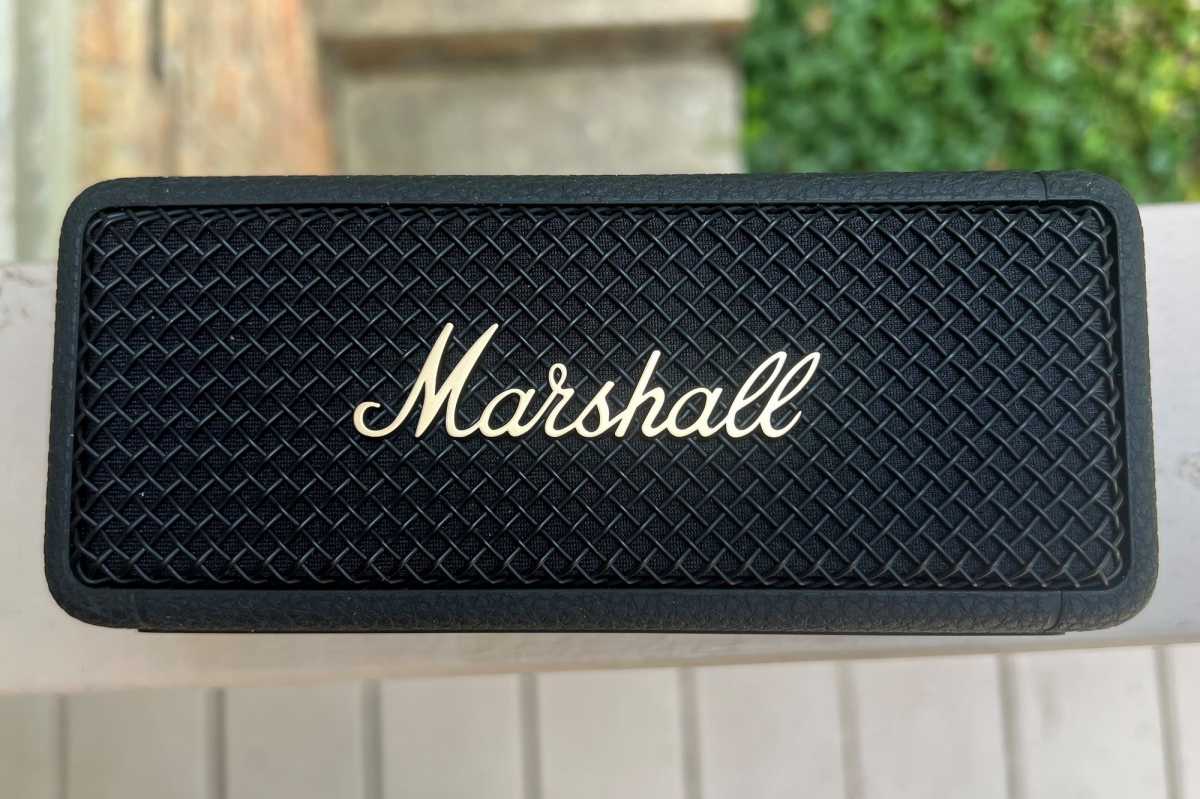
The proportions of an Emberton II speaker strongly recall the look of classic Marshall guitar amp heads.
James Barber/Foundry
How well is the Emberton II built?
The Emberton II’s 2.7 x 6.3 x 3.0-inch (HxWxD) proportions don’t exactly match those of Marshall’s classic amp heads like the JCM800 or the Silver Jubilee, but they’re close enough to the Emberton II’s looks to evoke those beloved models for anyone who’s a Marshall aficionado.
The Emberton II is available in black or cream, with a gold Marshall logo on the metal front grille. It weighs a solid 1.5 lbs. and feels sturdy enough to stand in for the paperweight or tabletop sculpture that Lt. Columbo would identify as the murder weapon on that 1970s TV show. The covering on the case frame effectively mimics the vinyl-on-wood cabinet from a real Marshall amp.
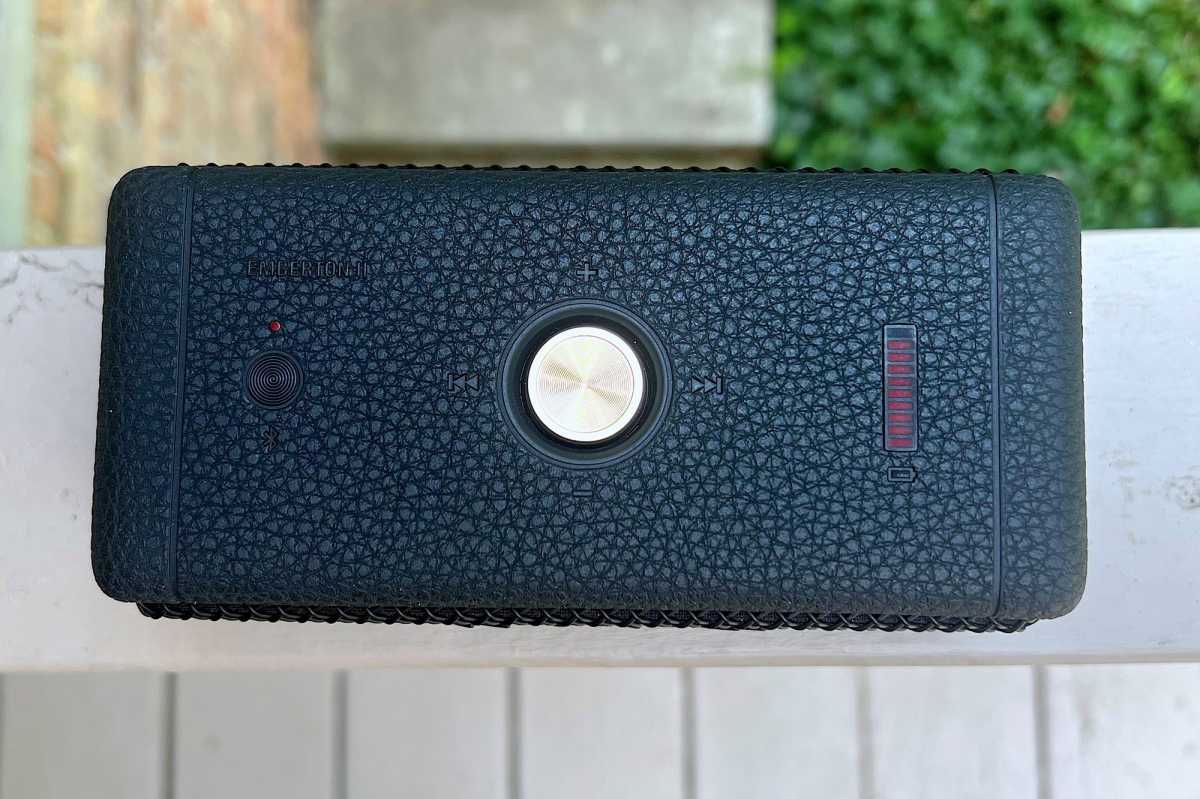
The Marshall Emberton II has a remarkably easy-to-use joystick controller on the top of the speaker.
James Barber/Foundry
Zound touts that the device is constructed of more than 50 percent post-consumer recycled plastic made from electronics, water bottles and automotive light covers, and that the speaker is 100 percent PVC-free. The Emberton II has an IP67 weatherization rating, which means it’s designed to keep out dust and survive being submerged in a meter of water for up to 30 minutes. (Want to know more about IP codes? Just click the preceding link.)
There’s a great on/off sound that recalls a guitar riff, and one that sounds like a pick scratch when there’s a Bluetooth connection. Battery life on the Emberton II reached the promised 30 hours on a three-hour charge. If you’re out of juice, a 20-minute quick charge yields four hours of playback.
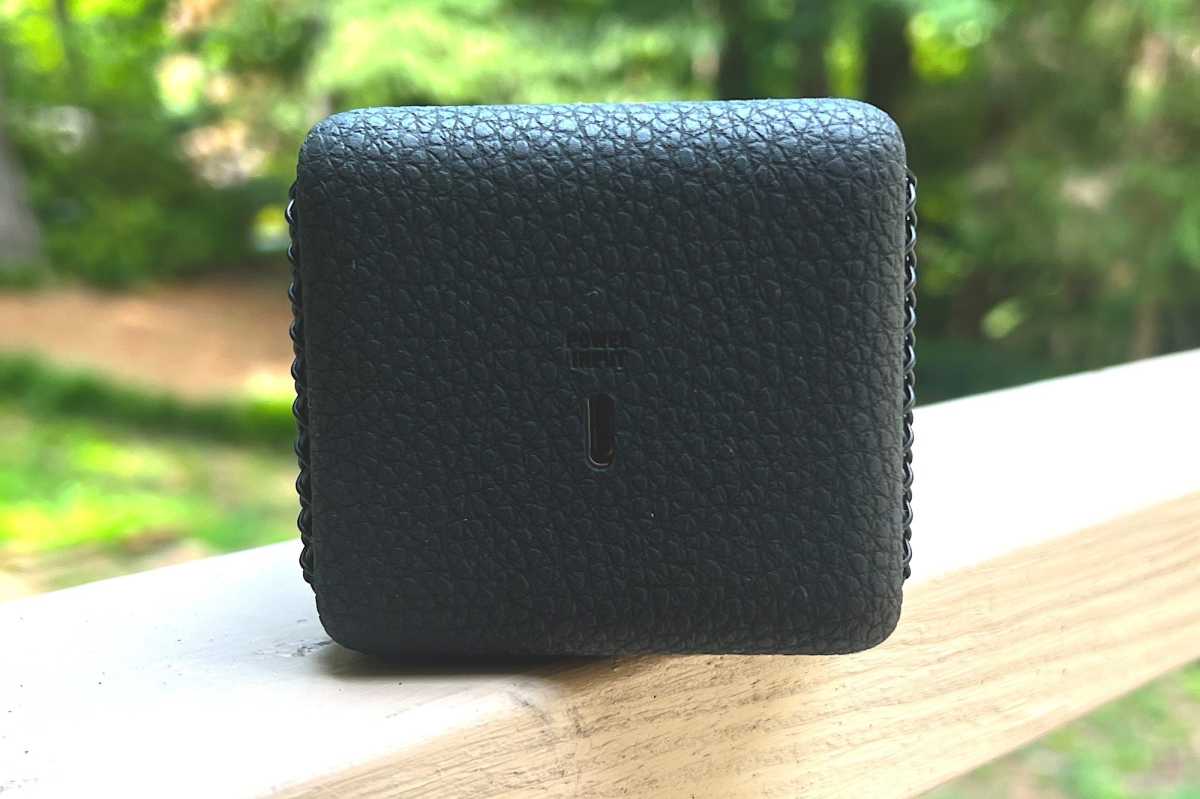
A USB-C charging port is the single opening on the largely waterproof Marshall Emberton II speaker.
James Barber/Foundry
There is a pair of 2-inch dynamic drivers and two passive radiators with a frequency range of 60Hz to 20kHz. One driver and one radiator is on the front of the speaker, with the others on the back. Marshall describes this as “stereo” sound, but you’re not getting left and right imaging since the audio’s pushed in two opposite directions. Still, it makes for a wide audio spread and impressive volume for the speaker’s size. Each of the active drivers is powered by a 10-watt Class D amplifier.
The speaker uses the Bluetooth 5.1 standard and the basic SBC codec. There’s no support for AAC, aptX, or other higher-quality codecs. Also missing from this speaker is a 3.5mm auxiliary port for a wired audio source, and there’s no microphone, so you can’t use the Emberton II as a speakerphone.
How do you operate the Emberton II?
A brass-colored metal joystick is the speaker’s main control mechanism. You’ll press down on it to turn the speaker on and off. Rock it to the left to skip back a track, and right to skip forward. You can increase its volume level by rocking back, and lower its volume by rocking forward.
There’s a battery meter that’s constantly lit and looks like the level meter on a cassette deck. The only other control on top of the speaker is the Bluetooth pairing button. There’s a USB-C port on the side of the speaker for charging.
How useful is the Marshall app?
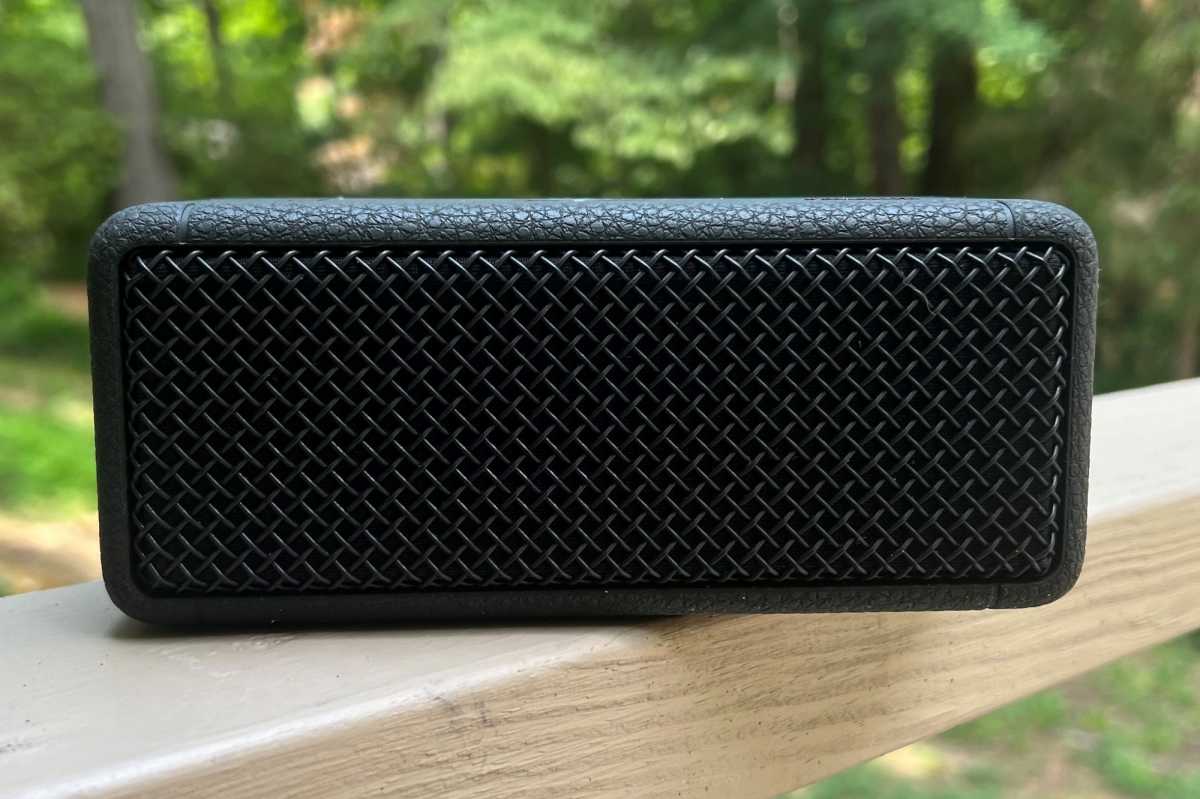
The back of the Marshall Emberton II has a driver and passive radiator that matches the ones on the front of the speaker.
James Barber/Foundry
Zound offers an app to tune its Marshall headphones and speakers. The app offers up three EQ presets, including Marshall (“the fine-tuned Marshall signature sound you know and love”), Push (“boosted bass and treble for an even heavier sound”), and Voice (“enhanced midrange for more clarity when listening to voice-focused content”).
There are instructions for Stack mode, which allows you to connect multiple Emberton II speakers for a bigger soundstage. While the instructions don’t explicitly say so, it’s hard to imagine you cannot use any other Marshall speaker that supports Stack mode in your audio array. Be aware, however, that two speakers operating in Stack mode will not function as a left/right stereo pair.
The app will handle any future speaker firmware updates that Marshall may release. If you want more Marshall speakers or headphones, you can access the store and order any model that’s still available. There’s a quick guide to operating the Emberton II within the app, and links to the complete user manuals for the entire Marshall line.
How does the Marshall Emberton II sound?
Larger Marshall Bluetooth speakers—like the Stanmore (read our Marshall Stanmore II review) and the Woburn—have long enjoyed reputations as some of the best-sounding and elegantly designed speakers for home use. The Emberton II is most definitely a personal-sized speaker (albeit a heavy and bulky one) and isn’t trying to match the home stereo quality pumped out by its larger siblings.
Across the board, the default Marshall EQ setting gives the best sound. If you’re listening to dance music like Idris Elba’s new single “Body Shots,” the Push setting gives the song’s house beats an extra thump, but the Emberton II isn’t ever going to pump out enough volume to fill a dance floor. If you listen to a lot of podcasts or audiobooks, the extra compression on the Push setting gives the lead voice center stage, but wipes out any sound design the show or book’s engineers worked to create. Unless you have a specific use case, stick with the Marshall EQ.
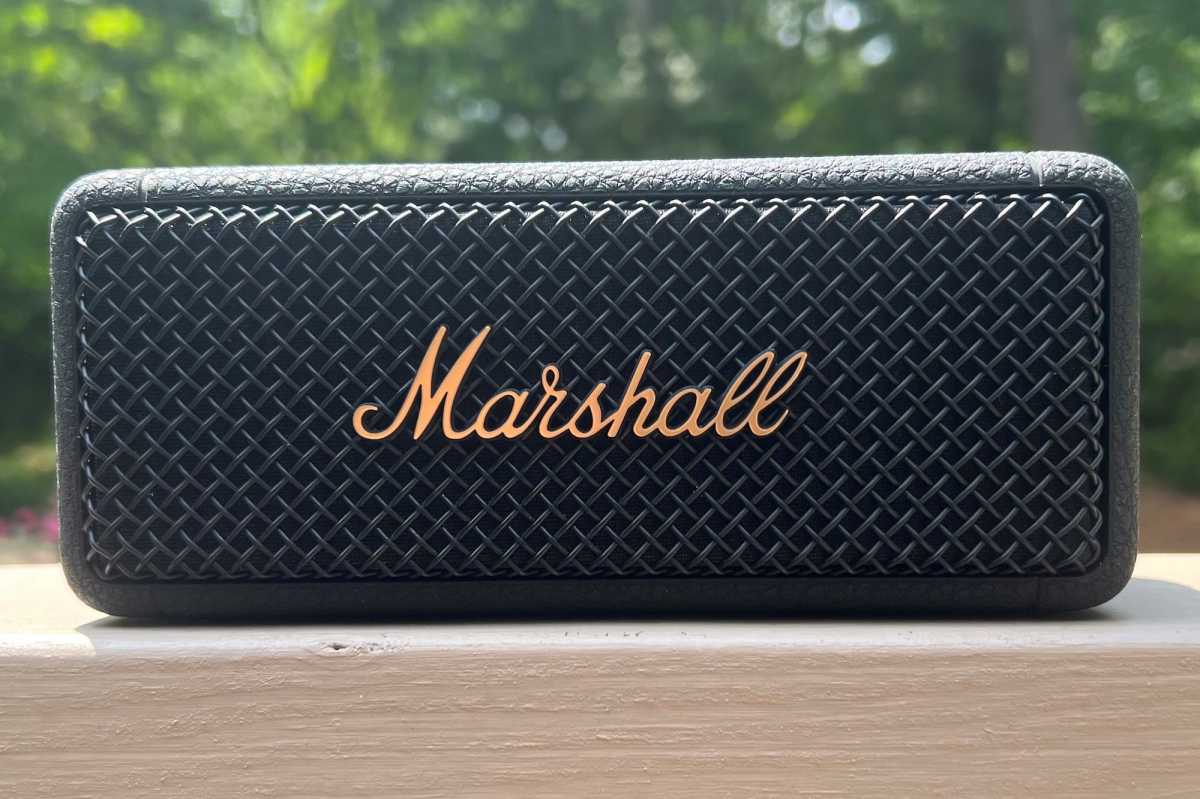
The Marshall Emberton II is roughly as wide as an iPhone 13 Pro Max is tall and as thick as that phone is wide.
James Barber/Foundry
When you get the volume to around 70 percent, you’re getting more sound than you might reasonably expect from a speaker this size. Once you start pushing past that point, though, the speaker begins to distort with a piercing harshness at the top end. Why didn’t Marshall calibrate the speaker so that its max volume was around 75 percent of what’s possible in the version they’re selling? If the volume on this speaker topped out where it should, there’d be no complaints about distortion and users would be impressed with how loud it was.
The Emberton II is a beautiful object. The construction is exceptional, the look is true to the Marshall brand, and the sold control joystick is especially satisfying to use. As someone who’s lugged Marshall amps into vans and trucks, spent years enjoying them in recording studios, and obsessively researching which guitars and amps made the sounds on the records I love, I’ll say I have a strong emotional reaction to the Marshall logo. At this price point, there are certainly larger Bluetooth speakers that can pump out higher volumes and work with higher-quality Bluetooth codecs, but the design, smooth sound, and robust construction of the Marshall Emberton II are hard to resist.




